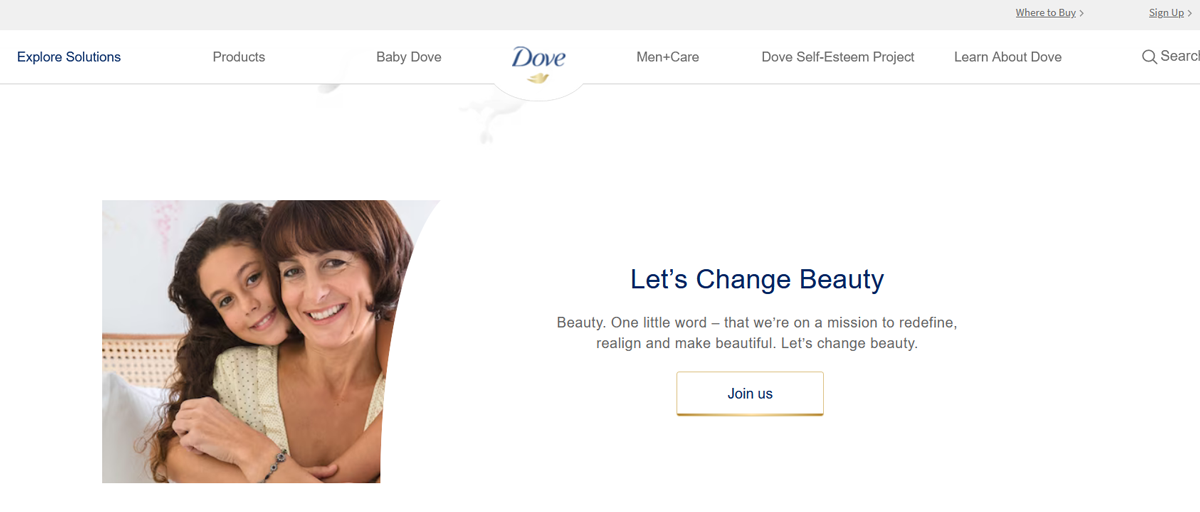If you look around, you will find that everything that you see has a substantial impact on your emotions and memory too. When it comes to graphics and visuals, most of them are designed to evoke some type of emotion. In branding, this stands truer than anything else. Just think about this for a moment. How have brands like Apple, Nike, or Dove connected with a mass audience worldwide? Mostly, by having an emotional impact.
With elements that evoke certain emotions like joy, happiness, and even loyalty, such companies continue to reach out to consumers across generations. Now, if I ask you to think about how any such brand has managed to evoke the right emotions, you will most likely think about their ads or social media engagements.

Image Source: dove.com
But I am going to take a slightly different direction here. The logo designs. How do famous logos bring out the desired reaction or feelings with design elements? Let’s take a look.
What is Emotional Design in Logos?
This is not a new phrase or term. Emotional design has been explored in detail by researcher, Donald Norman in a book by the name as well. He talks about how emotions can influence a consumer’s reaction to a product and make them feel happy, excited, or curious too. Now, this concept can be and is applied to visual elements too. In logos, graphic designers and brand owners collaborate to create a design that sends out the right message and evokes positive emotions.
Any business needs to get a professionally designed logo that represents its niche and helps boost recognition on a global scale. To achieve this goal, you need to pay a lot of attention to choosing elements in graphic design that can have a strong impact on the viewer. For instance, the colors or shapes in a brand symbol might cause people to react positively or negatively.
Colors
This is one of the most important elements of logo design. If you think about it, color psychology plays a critical role in the result. Most primary and complementary colors are used in emotional design to influence how the viewer feels when looking at visuals or graphics. Here are a few key colors and the emotions associated with them:
- Red: Excitement, energy, and passion
- Blue: Trust, security, and reliability
- Yellow: Happiness, warmth, and creativity
- Green: Prosperity, hope, and nature
- Pink: Femininity, friendship, and youthfulness
- White: Purity, elegance, and modernity
- Black: Power, balance, and authority
- Purple: Luxury, royalty, and celebration
Many brands choose solids, hues or tones, and accents to create a memorable and unique logo. You can find a lot of famous symbols like Michelin’s white and blue mascot logo or Amazon’s minimalist wordmark with the arrow. Both designs evoke the desired emotions and appeal to the audience globally. One thing to remember here is that the same colors may bring out different reactions depending on their cultural significance.

Image Source: Wikimedia

Image Source: Wikimedia
White, for example, is commonly associated with purity, but in a few Eastern regions, it represents sadness or death. So, it might bring out negative emotions among some people as well.
Shapes
Similar to the colors, the shapes are another important element of emotional design. Various geometric or abstract ones can make all the difference in some brand icons. Consider the example of an electronics company logo like LG.
The circular shape includes stylized letters forming the name of the brand. It also gives the impression of a smiling face and symbolizes youth and creativity.

Image Source: Wikimedia
Most geometric shapes are used to convey a message of authority to the viewers. Squares represent stability, structure, and balance while rounded or circular ones represent creativity and freedom, and will generally get a positive reaction from the audience.
Abstract shapes are often used by designers in logos to add a mysterious appeal and keep people thinking. You can take the example of the logo of Adidas here. It is one of the most famous abstract shapes that emotionally influences consumers. The three stripers that form a mountain are considered inspirational and can motivate people to act quickly.

Image Source: Wikimedia
Typography
In graphic design, font styles and typography alone can attract people or turn them away. You may already be familiar with famous wordmark logos like Google and Coca-Cola or letter marks like Adobe’s creative ‘A’. These text-based symbols are timeless and have required minimal upgrades over the years.

Image Source: Wikimedia
If you simply look at the design, you might just see a few letters put together, but when you observe any such logo closely, you will realize its impact on your perception.
Coca-Cola for example, has a distinct, free-flowing script that is recognized by people across the world. Its typography is a huge reason behind the emotional appeal of the logo and brand. People associate the design with a sense of familiarity, happiness, and joy. Similarly, a clear-cut logo like Adobe’s can inspire confidence with the modern style and highlight the expertise of the company as well.

Image Source: Wikimedia
How Famous Logos Connect with Emotional Design
Now, I have talked quite a bit about famous logos and how they manipulate certain design elements to evoke emotions. But now, let’s go into more detail about this. How do they achieve the desired results? What are some other factors that can be used to influence consumer perception? These are just a couple of questions that might have crossed your mind while reading the examples mentioned above.
To help you understand this, I am going to break down some major factors in logo design that can evoke an emotional reaction.
– Storytelling
This is one of the most crucial elements of an appealing design. In branding, storytelling can be used to form or shape public perception and to emotionally connect with potential customers. Many designers use some form of storytelling in web design for instance to improve user experience and keep the visitors scrolling through a website for a longer time. When it comes to logos, storytelling techniques can be applied in different ways.
You may think that to tell people your brand story, you need to create an elaborate design or go with illustrative imagery. This is not entirely correct. To evoke a strong emotional reaction from the audience, minimalist elements can also work wonders.
I mean, just look at WWF’s simple design with the panda. The use of animal imagery has helped the organization form an emotional connection with people everywhere.

Image Source: Wikimedia
Even people who are not loyal customers are familiar with the purpose and drive that is associated with the company. Similarly, there are other examples of brand symbols like Gucci’s two ‘Gs’ and Unilever’s letter marks that employ design elements like fonts and meaningful imagery to evoke emotions.

Image Source: Wikimedia
– Illustrations
It is a great way for brands to connect with potential customers on an emotional level. You can easily get the desired reaction with an illustration that shows people what the brand has to offer and how it is different from similar ones in the industry. One of the most well-known examples of a famous logo employing designs to evoke emotions is Starbucks. The siren is probably more widely recognized than any other image in the world!

Image Source: Wikimedia
If you want another example, take a look at Versace’s logo. The illustration of Medusa and its significance to the fashion house may be known to many people who are fans of the brand. With its black-and-white appearance, this design manages to convey luxury, elegance, and innovation. The label aims to make people feel good about themselves and trust in their abilities too.

Image Source: Wikimedia
Most logos that are illustrative can bring out the desired reaction from the audience from the first look. They may highlight the origins of a brand, its struggles, or stories. Sometimes, the emotional design may stay in your memory for a long time or get people talking about the meaning behind them.
– Characters or Mascots
A character can become an identifiable aspect of a logo design. It can be an original one that makes the design unique and easy to differentiate from competitors. Just take the example of Colonel Sanders of KFC. This character is certainly the star of the show here!

Image Source: Wikimedia
He’s commonly associated with the brand and is synonymous with fried chicken among young adults and children. Most companies create brand mascots or characters that can connect with their audiences across the globe.
Even if the company does not use it as its logo, such symbols can work for subsidiaries or be associated with specific products (Hello Pringles!). If you think about it, Mr. Pringles might just be more famous than the parent brand, Kellogg’s. This is primarily due to the emotional connection or appeal of the character.

Image Source: Wikimedia
Consumers of age demographics between 10 to 18 years, and older, associate the chips brand with its mascot. Such characters can add a personal touch to the design or humanize it. Many companies in the food and beverage industry opt for people logos for the human aspect. They can form a strong emotional connection with the audiences and bring out feelings of safety and joy among young adults and children too.
– Nostalgic Appearance
As Don Draper famously said, ‘nostalgia- it’s delicate but potent’, and for marketing and branding, there is no better way to put it.
In the last few years, nostalgic design has slowly made a comeback and is considered a dominant trend too. Hand-written text styles, vintage appearance and hues of beige and brown are being seen in a lot of logos recently. This is mainly due to their emotional impact on the viewer.
Many people associate nostalgic elements with happy memories or feelings of relaxation and peace. Logos such as Jack Daniel’s have a vintage appearance and are recognized for the use of emotional elements in the design such as old-timey fonts and borders.

Image Source: Wikimedia
Wrapping Up
These are some examples of how famous logos employ design to evoke emotions. To build a lasting relationship with your audience and foster loyalty, you need to add human elements or a personal touch to your logo design. Get started today and find inspiration from the examples above!
